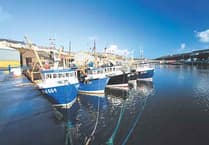Cosmic Girl has blasted off from Spaceport Cornwall on its historic flight to rapturous applause.
More than 2,000 people cheered as Virgin Orbit's modified Boeing 747 took off from the runway to the music of Rolling Stones' 1981 hit “Start Me Up,” which the satellite mission is named after.
Cosmic Girl will carry LauncherOne, a 70-foot-long rocket packed full of satellites, to an altitude of roughly 35,000 ft before the rocket is 'horizontally' dropped one hour after take off.
The flight path will see the plane track over the water in a westerly direction toward Ireland close to Cork.
Cosmic Girl will then make a left hand turn into what is called a 'race track' to release LauncherOne. It will make two passes. One a cold pass where aircraft and prevailing wind checks are carried out. A hot pass will then be carried out where the aircraft will undertake a pull up manoeuvre and drop LauncherOne.
The rocket will then engage its thrusters to launch itself into space at up to 17,500 mph, where it will deposit the satellites sometime between 1.15am and 1.30 am.
Dan Foster from Newquay, who is was part of the crowd, said: "The launch was amazing.
"It is history in the making. The atmosphere kept building and then the Cosmic Girl thundered up into the air. It was like a scene from a movie."
Cosmic Girl is earmarked to return to base between midnight and 1am. The satellite launch is Virgin Orbit’s first international launch and the first commercial launch from Western Europe.
LauncherOne will carry seven payloads into Lower Earth Orbit, which will span a wide range of activities aimed at improving life on planet Earth, including reducing the environmental impact of production; preventing illegal trafficking, smuggling, and terrorism; and a host of national security functions.
This will include the first ever satellite launched by the Sultanate of Oman focused on Earth Observation; future-facing return satellite tech aboard Wales’ first satellite, built by Space Forge; a Maritime monitoring payload built by Horizon Technologies and the Satellite Applications Catapult; as well satellites from the MOD, DSTL and US National Reconnaissance Office.V





Comments
This article has no comments yet. Be the first to leave a comment.